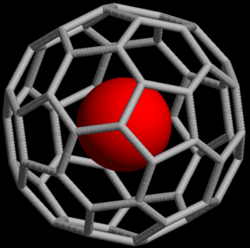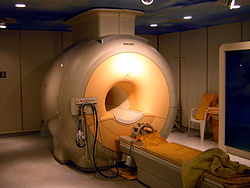Noble gas
The noble gases are a group of elements that are all gases. These elements are all in group 18 of the periodic table. All of them are monoatomic, meaning each molecule is a single atom. They almost never react with other elements.[1] This is because they have a full 8 electrons outer electron shell. There are six noble gases:
All of these gases are found in air. They make up around 0.96% of the atmosphere. Noble gas compounds can be formed from noble gases.
When the noble gases are used in cold cathode tubes to produce light, each of them has a different colour. Since Radon is radioactive, it is usually not used for lighting. Here are pictures of what the others look like:
Oganesson (element 118) is probably the next noble gas after Radon because it is the next box down in the same group. However it has a half life of 0.89 ms, after which it decays to Livermorium (Element 116). This means its use is probably limited.
Noble gases were discovered by Lord Rayleigh and Sir William Ramsay. Rayleigh won the Nobel Prize in Physics in 1904 for his work on noble gas.[2] Ramsay won the Nobel Prize in Chemistry in 1904 for his work with noble gas.[3]
Noble Gas Media
Helium was first detected in the Sun due to its characteristic spectral lines.
This is a plot of ionization potential versus atomic number. The noble gases have the largest ionization potential for each period, although period 7 is expected to break this trend because the predicted first ionization energy of oganesson (Z = 118) is lower than those of elements 110-112.
Neon, like all noble gases, has a full valence shell. Noble gases have eight electrons in their outermost shell, except in the case of helium, which has two.
Structure of xenon tetrafluoride (XeF4), one of the first noble gas compounds to be discovered
15,000-watt xenon short-arc lamp used in IMAX projectors
Sampling of noble gases using a Giggenbach bottle, a funnel is placed on top of the hot spring to focus the stream of sample towards the bottle via the Tygon tube. A geochemist is controlling the flow of the sample inlet using a Teflon valve. Note the condensation process inside the evacuated Giggenbach bottle.
References
- ↑ Ozima, Minoru; Podosek, Frank A. (2002). Noble Gas Geochemistry. Cambridge University Press. ISBN 0-521-80366-7.[dead link]
- ↑ "Rayleigh, John William Strutt, 3rd Baron". from Chambers Biographical Dictionary. 2007. Retrieved 30 July 2011.
- ↑ "Ramsay, Sir William". Chambers Biographical Dictionary. 2007. Retrieved 30 July 2011.













